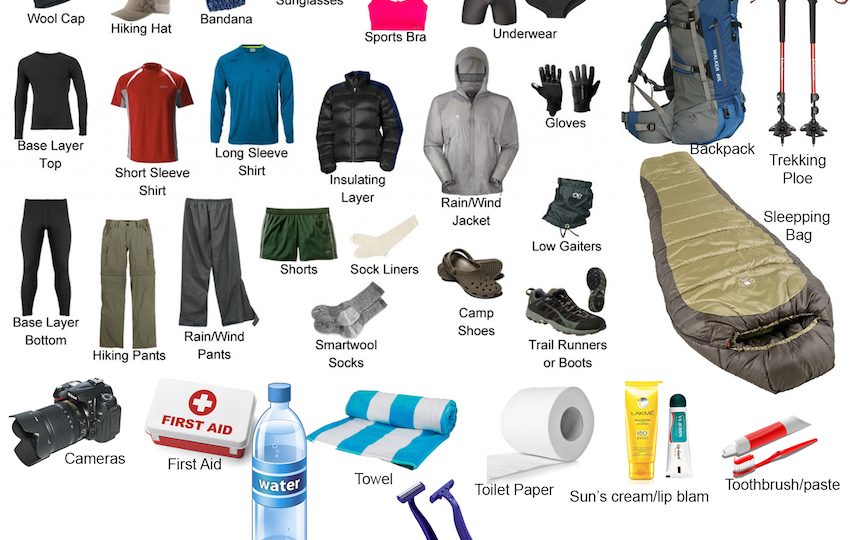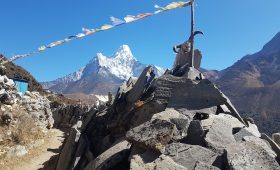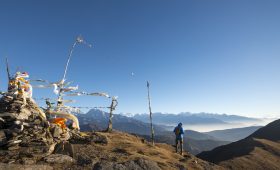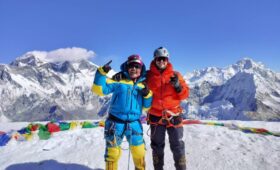Here is a full overview of what to bring if you consider a trek to Everest Base Camp or any other Nepal tea-house trek. Everest Base Camp trek packing list with proper preparation and equipment for the weather conditions will ensure that you have a great trekking experience.
What follows is a pretty comprehensive list and will ensure that in the coldest months of the year you are covered. If you have questions about what you might need simply ask us, keep in mind that Kathmandu is a great place to buy trekking equipment at affordable prices.
Everest Base Camp Packing list, the first thing to consider is that your gear will divide between what you’re carrying in a day pack and what the porters are carrying the mountain in a duffel bag for you.
Note: The duffel bag will be provided and you can leave any extra luggage at the hotel.
The porters will take your duffel at the start of every morning and carry it to the next tea house. What this means is that you need to pack a daypack with everything you need for the day of trekking, as it will be difficult to access any of the equipment carried by the porters until the evening when you arrive at the tea house.
You can keep your daypack as small as possible to make trekking easier and only bring what you really need when hiking, such as snacks, phone, headlamp, poncho, extra layers, sun protection and water bottles.
Nepal is a great place to buy new trekking gear and equipment if you’re on a budget and you can find almost everything you need foe Nepal trekking. Prices are incredibly low and I buy all of my cold weather clothes in Kathmandu personally, but you have to be careful to avoid some of the cheap knockoffs.
Make sure that the zipper is strong in construction and that it works before you buy anything. Look at the stitching to make sure that the quality is good and it doesn’t come apart.
When you buy a pack, pay special attention to where the straps are attached to the pack to make sure it is stitched and solid. If you want brand name gear or really top-quality stuff, maybe Kathmandu isn’t the place to be, but if you want to save a lot and have some pretty good equipment, it’s a great choice.
The great thing about tea house trekking is you can easily buy it along the way if you forget anything. Namche Bazaar, reached on the second night of the trek, has many shops that sell sporting goods and souvenirs.
Namche Bazaar also hosts a number of pharmacies and book stores as well as an ATM that works generally. If you happen to be on a Saturday morning, you can check out the weekly market when the local Sherpa from the surrounding villages are in the middle of the city and exchange everything from electronics to sports goods.
You will also find a few other places along the journey to buy things like shirts, medication, snacks and books, but the range is not as good anywhere. Always keep in mind that the higher you get on the mountain, the more expensive it is, and your best option is to get it all in Kathmandu and bring it with you.
Everest Base Camp Trek Packing List
All you need to know about your Trek to Everest Base Camp.
- Gloves, wind breaker and poncho
- Sunscreens
- Lip-balm with Sunscreen
- Hat (for sun protection)
- Water purification Tablets (personal choice)
- Water Bottles/ Camel Back
- Sunglasses
- Headlamp +batteries
- Snacks
- Waterproof bag to protect electronics or paperwork
- Camera + batteries + memory cards
- Umbrella
- Duct tape / moleskin for blisters
- Toilet Paper
- Hiking Poles (Himalaya Discovery provides)
- Thermos (hot beverages)
If you’re going in March, April or October, November you’re probably expecting pretty good weather, and you might even find yourself trekking in shorts and a lower elevation t-shirt. When you gain altitude, although, it becomes increasingly colder, and any time of year the base camp can be below freezing. So, it’s best to get ready for cold weather and just bring those few extra layers in the case. Layering your clothes allows you to easily control the temperature of your skin by adding or removing layers or simply removing them.
The Base Layer is the first layer of clothing that you should put on in the cold and should help the body to maintain a steady temperature by providing extra warmth and sweating away. Look for fabrics like Cap Ilene or Merino Wool as it will absorb moisture from cotton materials and defeat the base layer function.
- long sleeve tee-shirts (2)
- Quick-day tee-shirts (2)
- Long underwear (2)
- Underwear (4 to 7)
Middle Layers: A middle layer is your insulating layer and a heavy down jacket and fleece is the best option. Choose a jacket that is easy to zip and unzip so you can change the temperature without having to go to the trouble of always removing your jacket.
- Fleece and Down Jacket
- Long sleeve shirts (2)
- Sweatshirt (optional)
- Fleece Pants
- Hiking Pants (2)
Outer Layer: The outer layer provides protection against elements. You must select the best material that can be both breathable and waterproof. A nylon jacket or a plastic poncho is a cheaper alternative, but the downside is that these fabrics retain moisture in order to make it easier for your skin to control temperature.
- Gortex or Waterproof Jacket
- Rain Poncho that covers your day pack.
- Waterproof Pants
- Hats, Gloves and Gaiters
Hats: You should have a balaclava or wool hat that covers your ears when it’s warm a bandana or wide brimmed hat is important to protect you from the sun and when its cold.
Gloves: The best way to apply the layering principle here is to bring a lightweight glove and a heavier wool or down middle that you put over it when it’s extremely cold.
Gaiters: While it’s highly unlikely you’re going to walk through snow, it is possible. Gaiters are useful as a way to stay dry as they can shield you from dust on the road.
- Brimmed hat
- Wool hat (must cover ears)
- Lightweight Gloves
- Wool or Down Mittens
- Gaiters (optional)
- Footwear: Shoes and Socks
Hiking Shoes: The best option is to bring a pair of broken hiking boots and a lighter weight shoe that you can wear after hiking in the evening.
The option of footwear depends on the personal preference, and if you normally walk in tennis shoes then you may be able to do the same to base camp as the trail is fairly level without a lot of rocks, the downside to sport shoes is that they don’t provide any protection for the ankle and they’re not as comfortable as hiking shoes.
It is extremely important to have comfortable shoes and the most common mistake people make is to get too small boots. Ideally, your hiking boot should be fitted with extra room for socks but not so loose as to drop your heel when you walk. When you start to get a blister or your feet are uncomfortable with stopping and taking care of the situation before it becomes a real problem.
In addition to a thicker sock or two pairs of cotton sock, I suggest you try a lightweight sock-liner to reduce friction. If this does not solve the problem, put a certain duct tape or moleskin over the area where a possible blister may grow.
Micro Spikes: If you are planning do the Gokyo Ri or the Everest three pass trek, it is recommended that you cross the passes. Although highly unlikely during the peak trekking months, on any of the treks in Nepal there is always a chance of snow and ice.
Most likely these will not be used, but it will help you plan for the worst by picking up a couple of these. Simple slip on spikes that easily attach to your shoes and do not require special buckles or belts (not to be confused with spikes).
Socks: A combine of wool sock and lightweight sock lining made of a material such as Capilene is the best option. Cotton socks are going to work as well, but you should make sure that every day you bring a fresh pair.
- Trekking boots with ankle support
- Camp shoes or Sport Shoes
- Plastic bag to carry spare shoes
- Socks (8 to 10)
- Sock Liners (optional)
- Sleeping Bag
Bring your own sleeping bag or buy one in Kathmandu is your best bet. We sell rental sleeping bags on request for USD 25 and down jacket rentals for USD 17 if necessary.
Guesthouses along the trail will provide a sheet covered mattress as well as a pillow, and in most situations, if you need it to cover your sleeping bag, you can even ask for an extra blanket.
- Sleeping bag rated to -15° C to -20°C / 0° f
- Sleeping bag stuff sack
- Duffel Bag and Day Pack
Note: Himalaya Discovery provides a large duffel bag. We suggest you bring few dry bags for packing your gear inside the duffel bag.
- Duffel Bag for trekking Gear (for the trek)
- Day Pack for Carrying what you need during the day trek
- Cover for daypack waterproof
- Drybags in different sizes
- Sacks for dirty clothes/shoes
- First Aid Kit and Toiletries
Everest Base Camp Trek First Aid Kit
We recommend you also carry the following items;
- Advil or Ibuprofen
- Diamox (for altitude sickness, AMS)
- Personal Prescriptions
- Rehydration Gels or Powder
- Medical Tape (for preventing listers)
- Antibiotics (Cipro for diarrhea)
- Diaper Rash Cream (for rashes or chaffing)
- Basic toiletries (Soap, Deodorant, toilet paper…)
- Wet wipes, Panty Liners and Tampoons
- Face lotion, Hair brush and Hair ties
- Hand warmers Ear plugs for sleeping
- Paperwork and cash money
You should bring enough money along the way to buy snacks and drinks or anything else you’d like to shop for. In Namche, you can find an ATM but don’t count on it to work.
If you’ve had a great time, your porters and guide will appreciate a tip best given at the end of the trek in Lukla before you fly back to Kathmandu.
Everest Base Camp Trek Difficulty – Is it doable?
The terrain is moderate on another route. It’s well marked to walk, so you don’t have to suffer. Gorakshep 5165 meters (Kala Pathhar 5645 meters optional) which is the highest point reached by trekkers during the Everest Base Camp trek. Kala Patthar is the main attractions during the Everest Base Camp trek because of its views.
The atmosphere has a low oxygen level and low air pressure. This way most of the travelers get tired after the trek. Gorgeous landscapes, warm Sherpa culture and the lifestyle of the real Himalayan Mountains make it easy to forget stress and tiredness.
Final Say
If you think something is missing from our Everest Base Camp trek packing list, then we would love to hear your suggestions. If you have any questions about this Everest Base Camp trek packing list, please leave a comment or simply contact us we will respond within 24 hours.
Do you have any question about trip to Nepal?
Tell us about your trip to Nepal and what you expect from it. We will answer your questions in 24 hours and help you design a trip with a comfortable itinerary to best meet your needs.





